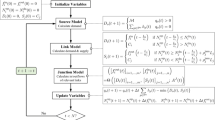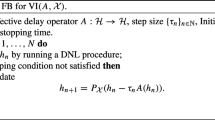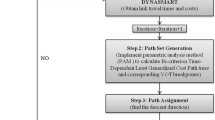Abstract
In this paper, we present an approach for determining dynamic user equilibria. The method is suitable for disaggregated microscopic and mesoscopic simulation-based models. It is a modification of the convex-simplex method, which disposes with the line search step, and controls the subset of travelers to be re-routed at each step while updating the link travel times after each assignment. To guarantee finite termination, a suitable stopping criterion is adopted. The proposed method is implemented within TRANSIMS, the Transportation Analysis and Simulation System, as a two-stage process that employs a combined use of link performance functions and a microsimulator in order to design a framework suitable for application to real transportation systems. To demonstrate this capability, we apply the developed methodology to a large-scale network, Bignet, which is part of the transportation city network of Portland, Oregon; and a medium-scale network, Blacksburg, Virginia; and provide some comparative analyses. Our results exhibit that an improved distribution of travelers is obtained while consuming less than 17–33% of the effort required by the current version of TRANSIMS.
Similar content being viewed by others
References
Barrett, C., Jacob, R., Marathe, M.: Formal-language-constrained path problems. SIAM J. Comput. 30, 809–837 (2001)
Bazaraa, M.S., Sherali, H.D., Shetty, C.M.: Nonlinear Programming, Theory and Algorithms, 2nd edn. John Wiley and Sons, New York, NY (1993)
DYNASMART, www.dynamictrafficassignment.org.
DynaMIT, www.dynamictrafficassignment.org.
Esser J., Nagel, K.: Iterative demand generation for transportation simulation. In: Hensher, D., King, J. (eds.) The Leading Edge of Travel Behavior Research, pp. 659–681. Pergamon, Oxford (2001)
Hobeika, A.G., Sherali, H.D., Jeenanunta, C., Jeihani M.: Transportation Analysis and Simulation System (TRANSIMS): Short Course Instruction Manual. Virginia Polytechnic Institute and State University, Blacksburg, VA (2003)
Jeihani, M., Hobeika, A.G., Sherali, H.D.: A Survey of Dynamic User Equilibrium Models in Transportation Networks. Virginia Polytechnic Institute and State University. Blacksburg, VA (2004)
Kaufmann, D.E., Smith, R.L, Wunderlich, K.E.: User equilibrium properties of fixed points in dynamic traffic assignment. Transport. Res. C 6, 1–16 (1998)
Leonard, D.R., Tough, J.B., Baguley, P.C.: CONTRAM: A Traffic Assignment Model for Predicting Flows and Queues during Peak Periods. Transportation ROAD Research Laboratory, TRRL Laboratory Report 841 (1978)
Lin, W., Lo, H.K.: Are the objective and solutions of dynamic user-equilibrium models always consistent? Transport. Res. A 34, 137–144 (2000)
Mahmassani, H.M.: Dynamic traffic assignment and simulation methodology for advanced system management applications. Networks Spatial Econ. 1, 267–292 (2001)
Nagel, K.: Fast Low Fidelity Microsimulation of Vehicle Traffic on Supercomputers. Transportation Research Board Annual Meeting, Washington D.C (1994)
Nagel, K., Axhausen, K.: Microsimulation. In: Hensher, D., King J. (eds) The Leading Edge of Travel Behavior Research, pp. 209–216. Pergamon, Oxford (2001)
Nagel, K., Beckman, R.J., Barrett, C.L.: TRANSIMS for transportation planning. InterJ. Complex Syst. 244, http://interjournal.org (1998a)
Nagel K., Rickert M.: Parallel implementation of the TRANSIMS microsimulation. Parallel Comput. 27(12), 1611–1639 (2001)
Nagel, K., Rickert, M., Simon, P.M., Pieck, M.: The Dynamics of Iterated Transportation Simulation. Los Alamos National Laboratory, LA-UR 98-2168, Los Alamos, NM (1998b)
Nagel, K., Schleicher, A.: Microscopic traffic modeling on parallel high performance computers. Parallel Comput. 20, 125–146 (1994)
Nagel, K., Wolf, D.E., Wagner, P., Simon, P.E.: Two-lane traffic rules for cellular automata: a systematic approach. Phys. Rev. E 58(2), 1425–1437 (1998)
Nguyen, S.: An algorithm for the traffic assignment problem. Transport. Sci. 8(3), 203–216 (1974)
Oppenheim, N.: Urban Travel Demand Modeling: From Individual Choice to General Equilibrium. John Wiley and Sons, New York NY (1995)
Peeta, S., Ziliaskopoulos, A.: Foundations of dynamic traffic assignment: the past, the present, and the future. Networks Spatial Econ. 1, 233–265 (2001)
Portland Study: Documentation, http://transims.tsasa.lanl.gov (2001)
Raney, B. Nagel, K.: Iterative Route Planning for Modular Transportation Simulation. Department of Computer Science, ETH, Zurich, Switzerland, www.inf.ethz.ch/personal/nagel/papers (2002)
Sheffi: Y.: Urban Transportation Networks: Equilibrium Analysis with Mathematical Programming Methods. Prentice Hall, Englewood Cliffs NJ (1985)
TRANSIMS 3.1: Documentation, http://transims.tsasa.lanl.gov (2003)
Author information
Authors and Affiliations
Corresponding author
Rights and permissions
About this article
Cite this article
Jeihani, M., Sherali, H.D. & Hobeika, A.G. Computing dynamic user equilibria for large-scale transportation networks. Transportation 33, 589–604 (2006). https://doi.org/10.1007/s11116-006-7473-5
Received:
Accepted:
Published:
Issue Date:
DOI: https://doi.org/10.1007/s11116-006-7473-5




